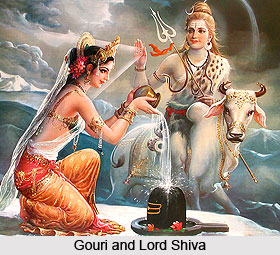 Agni Purana has described the discourse of the Gouri Vrata in one of its chapters. It has been stated in the Purana that the performer of the Vrata, should bathe with the seeds of sessamum on the head that day, and worship Hara, and his goddess alone with golden fruits etc. The feet of the divine lord should be worshipped by repeating the Mantra. At the knee-joints of the god, the worshipper should offer flowers, by repeating the Mantra. It has been stated that the various body parts of the god should be worshipped with different Mantras. Just as the various body parts of the god are worshipped similarly the different body parts of the goddess should also be offered obeisance.
Agni Purana has described the discourse of the Gouri Vrata in one of its chapters. It has been stated in the Purana that the performer of the Vrata, should bathe with the seeds of sessamum on the head that day, and worship Hara, and his goddess alone with golden fruits etc. The feet of the divine lord should be worshipped by repeating the Mantra. At the knee-joints of the god, the worshipper should offer flowers, by repeating the Mantra. It has been stated that the various body parts of the god should be worshipped with different Mantras. Just as the various body parts of the god are worshipped similarly the different body parts of the goddess should also be offered obeisance.
It has been mentioned in the Purana that along with Uma Maheshwara, the eight goddess of Sobhagaya should also be worshipped. Clarified butter, cleansed saffron, Jivaka, Taruraj, sugarcane and Shindhuvara should be placed before the group of the eight goddesses of energy (Soubhagya etc.) in the month of Chaitra. The worshipper should live on Shringodaka, and sleep before the images of the divine pair. He should bathe in the morning, and worship a married Brahmana couple. The eight articles enumerated above, should be made over to a Brahmana, by repeating the Mantra. The leaves of Bel fruit, cow dung, Mandara, washings or Shringa and the blades of Kusha grass, curd, thickener, milk, and clarified butter mixed with water, should be given in the month of Kartika.
Agni Purana narrates that each of the eight goddesses of energy, should be addressed as "Be pleased, oh thou Lalita; be pleased, oh thou Vijaya; be pleased, oh thou Bhadra; be pleased, o thou Bhavani; be pleased, oh thou Kumuda; be pleased oh thou Shiva; be pleased, oh thou Vasudevi; be pleased oh thou Gouri ; be pleased, oh thou Mangala, and be please: oh thou Sati, at the time of making the gifts in the months of Chaitra and others."
Finally it has been said that at the close of the Vrata, fruits, holy thread, a bed, a quantity of clarified butter, as well as s golden bull and a cow, and the golden images of Uma and Maheshwara should be given to a Brahmana. The preceptor as well as a Brahman husband and a wife, should be propitiated with presents of clothes, etc, whereby the Vrati would enjoy all the comforts of this world and attain salvation.
It has been stated towards the end of the chapter that a man attains good luck, health, beauty and longevity, by performing the Vratam, known as the Soubhagya Shayanam which should be performed on the day of the third phase of the moon`s increase.



















